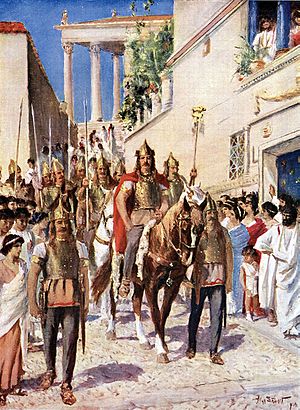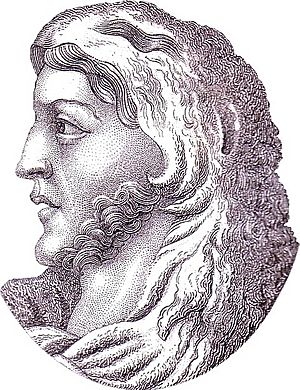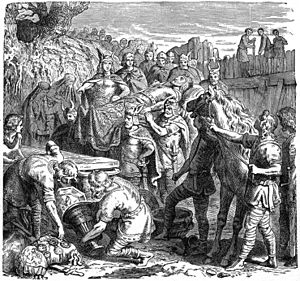Alaric I facts for kids
Quick facts for kids Flavius Alaricus |
|
|---|---|

1920s artistic depiction of Alaric parading through Athens after conquering the city in 395
|
|
| King of the Visigoths | |
| Reign | 395–410 |
| Coronation | 395 |
| Predecessor | Athanaric |
| Successor | Ataulf |
| Born | Unknown, c. 370? Peuce Island, Dobruja (now Romania) |
| Died | 410 (aged around 40) Consentia, Italia, Roman Empire (now Cosenza, Italy) |
| Burial | Busento River, Calabria, Italy |
| Dynasty | Balt |
| Father | Unknown |
| Religion | Arianism |
Alaric I (around 370 AD – 410 AD) was the first king of the Visigoths. The Visigoths were a powerful Germanic people. Alaric led them from 395 to 410. He became their leader after they had settled in a Roman area called Moesia. This land was gained by Goths and Alans after a big battle called Battle of Adrianople.
Alaric started his career as a soldier. He worked for a Gothic leader named Gainas and then joined the Roman army. He was once an ally of the Roman Emperor Theodosius. Alaric even helped defeat other groups who wanted to take over the Roman Empire.
Even though many of his men died, Alaric felt he didn't get enough credit from Rome. He left the Roman army feeling disappointed. After Emperor Theodosius died in 395, Alaric became known as the king of the Visigoths. He led the strongest army in the Balkans. He wanted Rome to officially recognize his power, but this never fully happened.
Alaric mostly fought against the Western Roman Empire. He marched into Italy, where he later died. He is famous for leading the sack of Rome in 410. This event was a major sign of the Western Roman Empire's decline.
Contents
Early Life and Becoming a Roman Ally
According to a historian named Jordanes, Alaric was born on Peuce Island. This island is located where the Danube Delta meets the sea, in what is now Romania. Jordanes said Alaric belonged to a noble Gothic family called the Balti dynasty. However, we can't be sure if this is completely true.
When Alaric was a child, the Goths faced problems from the Huns. This led many Goths to move across the Danube River. They then fought a war with Rome from 376 to 382. Alaric likely grew up near the Roman border during this time. This area was seen by Romans as a wild, faraway place.
Alaric's childhood was spent among Gothic soldiers. These soldiers had fought in the Battle of Adrianople in 378. In that battle, they defeated a large Roman army and killed Emperor Valens. After more fighting, a peace treaty was made in 382. This treaty allowed the Goths to live on Roman land. In return, they had to provide soldiers for the Roman army. They also got land to farm and were free from direct Roman rule. Many Goths, including Alaric, served in the Roman army during this time. They helped Emperor Theodosius in his campaigns.
Rising to Gothic Leadership
After the treaty of 382, more Goths gained high ranks in the Roman army. Alaric started his military career working for a Gothic soldier named Gainas. Later, he joined the Roman army.
Alaric first appeared as a leader in 391. He led a group of Goths and their allies who invaded Thrace. They were stopped by a Roman general named Stilicho. Even though a Roman poet called Alaric a "little-known menace," Alaric's skills and forces were strong enough to stop Emperor Theodosius from crossing a river.
By 392, Alaric was officially serving in the Roman military. In 394, he led a Gothic force that helped Emperor Theodosius. They fought against a Frankish leader named Arbogast at the Battle of Frigidus. Alaric's men were used in a very dangerous way, and about 10,000 of them died. Despite this huge loss, Alaric received little thanks from the emperor. Many Romans were even happy that so many Goths had died.
Alaric was one of the few who survived the bloody battle. He likely wondered if serving Rome was truly best for his people. He expected a promotion to a high military position, but he didn't get it. Feeling cheated, Alaric rebelled and began to march towards Constantinople.
On January 17, 395, Emperor Theodosius died. He left his young sons, Arcadius and Honorius, in the care of Stilicho. From 395, Alaric is known as the king of the Visigoths. A historian named Jordanes wrote that Alaric convinced his people to "seek a kingdom by their own efforts."
Actions in the Eastern Roman Empire
After Theodosius died, the Roman armies fell apart. The Empire was split between his two sons. One son ruled the Eastern part, and the other ruled the Western part. Stilicho became the powerful leader of the West. He also tried to control the East.
Alaric rebelled again. The rivalry between the East and West Roman Empires helped Alaric and his people. But simply being called king by his people wasn't enough. Alaric needed official Roman approval to get supplies from Roman cities.
Alaric led his Gothic army on what some called a "pillaging campaign" in the East. Some historians believe Alaric and his men were hired by the Eastern Roman government. They were sent to stop Stilicho's army. No major battle happened.
Alaric's forces marched through Greece in 396, going as far south as the Peloponnese peninsula. A Roman writer said Alaric's troops plundered the area. Stilicho attacked Alaric's forces and pushed them north. However, Stilicho's own troops also caused destruction.
Stilicho had to send some of his Eastern forces back to Constantinople. These troops were led by a Goth named Gainas. When Gainas arrived, he killed a powerful Eastern minister named Rufinus. Gainas was then given a high military position by Eutropius, the new main minister in the East.
In 397, Eutropius led his troops to victory over some Huns. This made him stronger. He then declared Stilicho an enemy and made Alaric a Roman general in Illyricum. This meant Alaric and his followers would get gold and grain. Negotiations for a lasting peace began.
Alaric's people were fairly quiet for the next two years. But in 399, Eutropius lost his power. The new Eastern Roman government no longer wanted Alaric's services. They transferred his province to the West. This took away Alaric's Roman rank and his right to supplies. This left Alaric's army, the only strong force in the Balkans, as a problem for Stilicho.
Invading Italy
Around spring 402, Alaric decided to invade Italy. Historians think he was desperate for supplies. He crossed the Alps near the city of Aquileia. For several months, there were reports of Gothic attacks in northern Italy. Alaric first met Stilicho on a Roman road.
Two battles were fought. The first was at Pollentia on Easter Sunday. Stilicho won a big victory, capturing Alaric's wife and children. He also took much of Alaric's treasure. Stilicho chased Alaric's retreating forces. He offered to return the prisoners, but Alaric refused.
The second battle was at Verona, where Alaric was defeated again. Surprisingly, Stilicho offered Alaric a truce and let him leave Italy. Historians believe Stilicho did this because he saw Alaric as a useful weapon against the Eastern Roman Empire. An agreement was likely made in 405, suggesting Alaric was working for the Western Romans. Between 404 and 405, Alaric stayed in a Roman province called Pannonia. From there, he could threaten both the East and West.
In 405, another large group of Goths and other groups, led by Radagaisus, invaded Italy. They plundered the countryside and attacked cities. Stilicho managed to defeat Radagaisus's forces. Meanwhile, Alaric, now supplied by the West, waited for a new mission.
Second Invasion of Italy
Around 406 and 407, more large groups of people like the Vandals, Sueves, and Alans crossed into Gaul. At the same time, a rebellion started in Britain and spread to Gaul. With so many enemies, Stilicho was under great pressure.
During this crisis in 407, Alaric marched on Italy again. He took a position in Noricum (modern Austria). He demanded 4,000 pounds of gold to prevent a full invasion. The Roman Senate hated the idea of paying Alaric. One senator famously said, "This is not peace, but a pact of servitude." But Stilicho paid Alaric the gold anyway. This agreement, while practical for the military, weakened Stilicho's standing with Emperor Honorius.
After a Roman Coup
In the East, Emperor Arcadius died in 408. His son Theodosius II took over. Stilicho seemed to plan to march to Constantinople to put a loyal ruler in power. He might also have planned to give Alaric an important job and send him against the rebels in Gaul.
But before Stilicho could do this, a bloody takeover happened at Honorius's court. It was led by Honorius's minister, Olympius. Stilicho's small group of Goths and Huns was attacked. Stilicho, now without an army, had to flee. Olympius's agents promised Stilicho safety, but then betrayed and killed him.
Alaric was again declared an enemy of the emperor. Olympius's men then killed the families of the Gothic soldiers who had been allied with Rome. These soldiers then joined Alaric. Thousands of them, with their families, joined Alaric in Noricum. Italy was left with no strong defenses.
As an "enemy of the emperor," Alaric could not legally collect taxes or hold cities. He offered to move his men to Pannonia in exchange for money and a modest title. But he was refused because Olympius saw him as a supporter of Stilicho.
First Siege of Rome
When Alaric was rejected, he led his army of about 30,000 men towards Rome. Many of these new soldiers were angry about their families being killed. He marched into Italy, bypassing the imperial court in Ravenna. In September 408, he surrounded Rome, cutting off its food supply.
No fighting happened this time. Alaric used hunger as his main weapon. When Roman senators tried to scare him by saying the desperate citizens might fight back, Alaric laughed. He famously replied, "The thicker the hay, the easier mowed!"
After long talks, the starving citizens agreed to pay a huge ransom. This included 5,000 pounds of gold, 30,000 pounds of silver, and many valuable goods. Alaric also recruited about 40,000 freed Gothic slaves. This ended Alaric's first siege of Rome.
Failed Agreement and Alaric's Own Emperor
After agreeing to Alaric's terms, Emperor Honorius changed his mind. One big problem was Alaric wanting to be named head of the Roman Army. Honorius would not agree to this.
When Alaric didn't get this title, he besieged Rome again in late 409. He also declared a Roman senator, Priscus Attalus, as a rival emperor. Alaric then received the military appointment he wanted from Attalus.
However, Attalus didn't listen to Alaric's advice. He lost control of the grain supply in Africa. Then, Attalus and Alaric marched on Ravenna. Honorius offered them good terms, but Attalus refused and demanded Honorius be removed from power. Honorius was about to flee when ships with 4,000 troops arrived from Constantinople. This made him strong again.
Since Honorius no longer needed to negotiate, Alaric removed Attalus as emperor. He hoped to restart talks with Ravenna.
Sack of Rome
Negotiations with Honorius might have worked if not for another attack by Sarus. Sarus was a hereditary enemy of Alaric's family. He attacked Alaric's men. Alaric saw this attack as coming from Ravenna and as a sign of bad faith from Honorius. Alaric's patience ran out, and he marched on Rome for a third and final time.
On August 24, 410, Alaric and his forces began to sack Rome. This attack lasted three days. It was reported that Emperor Honorius, safe in Ravenna, cried when he heard Rome had fallen. But he calmed down when he realized it was the city of Rome, not his pet chicken named "Roma," that had fallen.
A Christian writer, St. Jerome, wrote from Bethlehem: "A dreadful rumor reached us from the West. We heard that Rome was besieged... The city which had taken the whole world was itself taken."
However, Alaric ordered his men to spare anyone who took shelter in a church. When valuable items were taken from a church, Alaric ordered them returned. Some Christian observers even saw Alaric, who was a Christian, as God's punishment on Rome.
Historians believe Alaric's main goal was to get food supplies. His followers struggled to feed themselves and relied on Roman supplies. However, others say Alaric's Goths stripped the city of centuries of wealth. The damage was still visible many years later.
The fall of Rome to barbarian invaders was a huge shock to the Roman world. It was a psychological blow. Alaric, despite being a barbarian, wanted a Roman command. His problem was being caught between the rivalries of the Eastern and Western Empires.
Alaric's respect for Roman ways did not stop him from sacking the city. He left behind destruction and chaos. He also took important people, including the emperor's sister, Galla Placidia, with him when he left. Many other Italian towns also suffered from Alaric's forces. The number of people receiving food aid in Rome dropped significantly after the sack.
Move to Southern Italy and Death
The sack of Rome was a big blow to Roman morale. The people had also suffered two years of fear, hunger, and illness. But the Goths did not stay long in Rome. Just three days after the sack, Alaric marched his men south to Campania. He planned to sail to Sicily to get grain and supplies. However, a storm destroyed his fleet.
In early 411, while returning north through Italy, Alaric became ill and died. He likely died of a fever. According to legend, his body was buried under the Busento River. The river was temporarily moved so a grave could be dug. Alaric and some of his most valuable treasures were buried there. After the work was done, the river was turned back, and the captives who dug the grave were killed. This was to keep the burial place a secret.
Aftermath
Alaric was succeeded as leader of the Gothic army by his brother-in-law, Ataulf. Ataulf later married Honorius's sister, Galla Placidia. Alaric's leadership gave his people a strong sense of community. After his death, Alaric's Goths stayed together within the Roman Empire. They eventually settled in Gaul, in a province called Aquitaine. There, they created the first independent barbarian kingdom inside the Roman Empire's borders.
This happened after Honorius officially gave Aquitaine to them around 418 or 419. Not long after Alaric's actions in Rome and Ataulf's settlement, many other Germanic groups began to control Western Roman provinces. These included the Vandals in Spain and Africa, the Visigoths in Spain and Aquitaine, the Burgundians along the Rhine, and the Franks in Gaul.
See Also
 In Spanish: Alarico I para niños
In Spanish: Alarico I para niños



